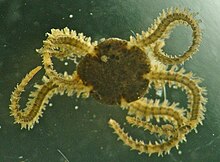| Amphiuridae Temporal range: Jurassic - present | |
|---|---|

| |
| Amphipholis squamata | |
| Scientific classification | |
| Domain: | Eukaryota |
| Kingdom: | Animalia |
| Phylum: | Echinodermata |
| Class: | Ophiuroidea |
| Order: | Ophiurida |
| Suborder: | Gnathophiurina |
| Family: | Amphiuridae Ljungman, 1867 |
| Genera | |
|
See text | |
Amphiuridae (commonly called long-armed burrowing brittle stars or burrowing brittle stars) are a large family of brittle stars of the suborder Gnathophiurina. Some species are used to study echinoderm development (e.g. Amphipholis kochii and Amphioplus abditus) and bioluminescence (the dwarf brittle star, Amphipholis squamata).
Characteristics
Amphiuridae are generally small brittlestars. Their jaws are always with two apical papillae at the tip, and one or more papillae on each side.
Systematics and phylogeny
Amphiuridae are the most diverse family of Ophiurida with over 200 species. The family contains the following genera:
|
|
In addition, two extinct genera are known:
- † Deckersamphiura Jagt, 2000
- † Xanthamphiura Hess 1970
Ecology
Amphiuridae are found in oceans worldwide from tropics to Arctic and Antarctic regions, with some species living in brackish water. They live mostly by burrowing in the seafloor or hiding under rocks. Most of them are herbivores feeding directly on algae, or detritus feeders, using their long arms to direct organic materials towards their mouths.
Though most amphiurid brittlestars broadcast their eggs and sperm into the sea, many species in this family are "brooders" and carry their young in bursae. One species, Amphiodia akosmos from the Monterey Peninsula of California, was found with up to 11 brooding embryos in one adult (Hendler and Bundrick, 2001).
References
- J. Roman, G. Breton, and C. Vadon. 1993. Ophiurides et Astéride (Echinodermata) du Tithonien de Canjuers (Var, France). Annales de Paléontologie 79(1):1-18
- P.Lambert, Checklist of the Echinoderms of British Columbia (April 2007), Royal British Columbia Museum
- Yamashita,M., Embryonic Development of the Brittle-Star Amphipholis kochii in Laboratory Culture, Biol. Bull. 169: 131-142(Aug., 1985)
- Hendler,G, Development of Amphioplus abditus (Verrill) (Echinodermata: Ophiuroidea): I. Larval Biology,Biol.Bull., Vol.152, No.1 (Feb., 1977)
- P.Brehm, J.G. Morin. Localization and Characterization of Luminescent Cells in Ophiopsila californica and Amphipholis squamata (Echinodermata: Ophiuroidea) Biological Bulletin, Vol. 152, No. 1 (Feb., 1977)
- Dewael Y, Mallefet J., Luminescence in ophiuroids (Echinodermata) does not share a common nervous control in all species, J Exp Biol. 2002 Mar;205
- Hendler,G. Ophiuroid Skeleton Ontogeny Reveals Homologies Among Skeletal Plates of Adults: A Study of Amphiura filiformis, Amphiura stimpsonii and Ophiophragmus filograneus (Echinodermata), Biol.Bull. 174:20-29.(Feb.1988)
- MarineSpecies.org - Amphiuridae Ljungman, 1867
- Formerly Micropholis Thomas, 1966 (non Huxley 1859: preoccupied)
- The Paleobiology Database
- R.L.Turner, Effects of Long-Term Exposure to Low Salinity on the Brackish-water Amphiurid Brittlestar Ophiophragmus filograneus (Lyman, 1875) From the Indian River Lagoon, Florida.Florida Scientist, Vol 70, 4 (Sept.2007)
- Hendler, G. & Bundrick, C. 2001. A new brooding brittle star from California (Echinodermata: Ophiuroidea: Amphiuridae). Contributions in Science from the Natural History Museum of Los Angeles County, 486, pp 1-11



